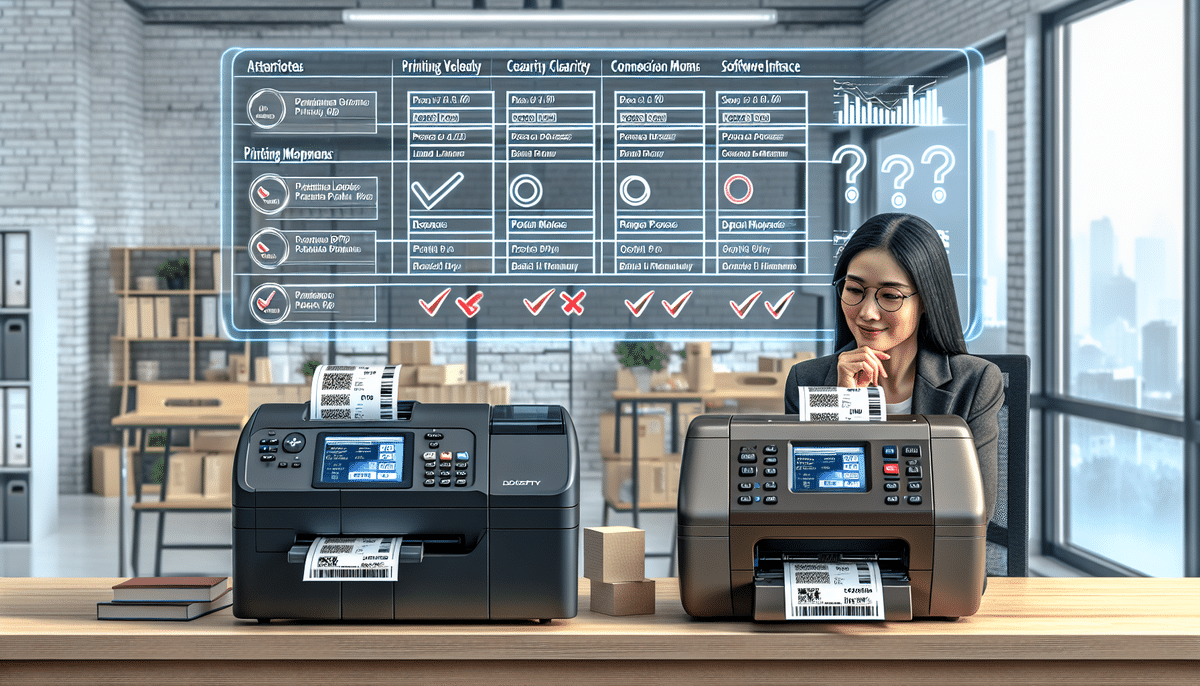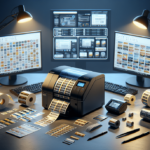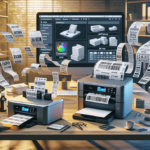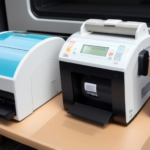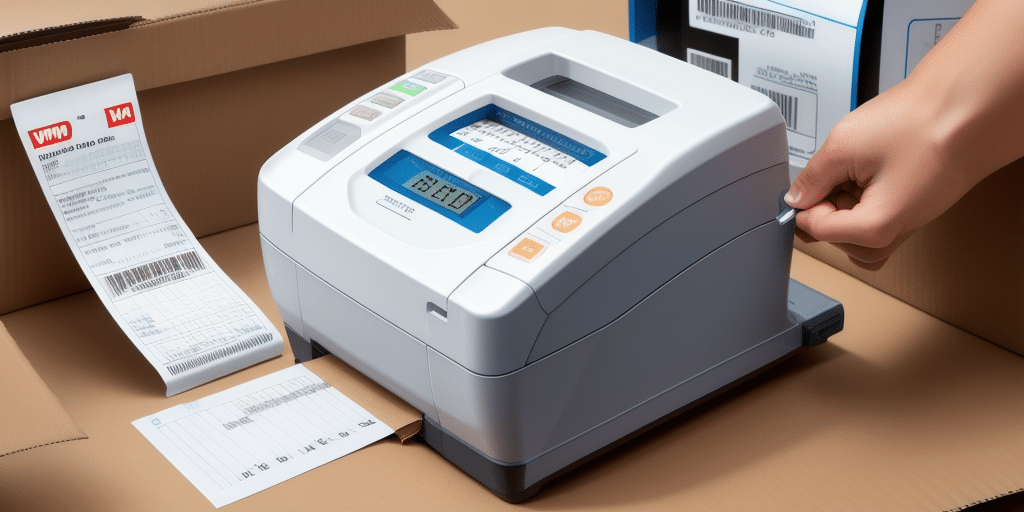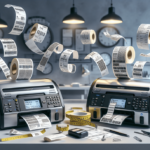Introduction to Label Printers
Label printers are essential tools for businesses and individuals seeking to create clear, professional labels for items such as packages, envelopes, folders, and products. Utilizing a label printer can significantly reduce time and costs compared to manual labeling or outsourcing to third-party printing services. Moreover, label printers offer customization options for label designs, text, and graphics, enhancing inventory management and organization through precise labeling.
There are various types of label printers available, including thermal transfer, direct thermal, and inkjet printers. Each type offers unique advantages tailored to specific needs. For instance, thermal transfer printers are perfect for producing high-quality, long-lasting labels, while direct thermal printers are more economical for short-term labeling requirements. Inkjet printers provide the flexibility to print in color on diverse materials, making them ideal for creative labeling projects.
Advancements in label printer technology have introduced features such as wireless connectivity, mobile printing, and automatic label cutting, increasing convenience and efficiency for businesses operating in multiple locations or needing on-the-go labeling solutions. With the growing demand for accurate labeling and packaging across various industries, label printers have become indispensable tools for enhancing operational efficiency.
Comparing Brother QL-1100 and DYMO LabelWriter 4XL
Key Features
Brother QL-1100 Features
The Brother QL-1100 is a versatile label printer supporting label widths up to 4 inches. It offers a high resolution of 300 dpi, ensuring sharp and legible labels. Capable of printing up to 69 labels per minute, the QL-1100 is ideal for handling large print jobs efficiently. Key features include:
- Built-in label cutter for various sizes and shapes, including round labels
- USB connectivity compatible with PC and Mac
- Automatic label sensor for adjusting settings based on label size and type
- Compatibility with Brother’s P-Touch Editor software for customizable labels
- Large backlit display for easy label design and editing
- Mobile printing capabilities via the Brother iPrint&Label app
DYMO LabelWriter 4XL Features
The DYMO LabelWriter 4XL is another popular label printer, also supporting labels up to 4 inches wide but with a higher resolution of 600 dpi. It prints up to 53 labels per minute and includes a built-in cutter for standard label shapes. Notable features include:
- USB connectivity for PC and Mac
- Proprietary DYMO Connect software for label customization
- Templates for various label types, including shipping and name badges
- Higher print resolution for more detailed labels
Design and Build Quality
Both the Brother QL-1100 and the DYMO LabelWriter 4XL boast sleek, compact designs made from durable materials. The QL-1100 features a white and black color scheme, while the 4XL is all black. Both models include a clear window to monitor label levels. However, the Brother QL-1100 has a larger footprint, which may be a consideration for those with limited workspace.
Print Speed and Resolution
The Brother QL-1100 offers a higher print speed of up to 69 labels per minute compared to the DYMO LabelWriter 4XL’s 53 labels per minute. However, the DYMO 4XL compensates with a superior print resolution of 600 dpi, allowing for more detailed and sharper labels. This makes the DYMO model preferable for applications requiring high-quality prints, such as barcode labeling.
Connectivity and Software
Both printers connect to PCs and Macs via USB. The Brother QL-1100 additionally offers Ethernet connectivity and mobile printing through the Brother iPrint&Label app, enhancing its versatility for networked environments and mobile use. The DYMO LabelWriter 4XL relies on its proprietary DYMO Connect software, which provides robust label customization options but lacks mobile printing capabilities.
Label Compatibility and Costs
Label compatibility is a critical factor when choosing a label printer. The Brother QL-1100 uses Brother DK labels, known for their affordability and compatibility with third-party brands. In contrast, the DYMO LabelWriter 4XL uses DYMO labels, which are often praised for their durability but come at a higher cost. Over time, the choice between these label types may depend on budget constraints and the specific durability requirements of your labeling needs.
User Experience and Support
User reviews highlight both printers' strengths and weaknesses. The Brother QL-1100 is appreciated for its automatic label sensor and mobile printing features, making it user-friendly for those needing versatile connectivity. Conversely, the DYMO LabelWriter 4XL is favored for its high-resolution prints and intuitive software, although some users have encountered compatibility issues with Mac OS. Both Brother and DYMO provide customer support and warranty options, with Brother offering a two-year limited warranty and DYMO offering a one-year limited warranty.
Pros and Cons
Brother QL-1100
- Pros:
- Supports a wide range of label sizes
- High print speed
- Automatic label sensor
- Mobile device printing
- Plug and Label feature for quick printing without software
- Cons:
- Larger footprint may require more desk space
- Lower resolution compared to DYMO LabelWriter 4XL
DYMO LabelWriter 4XL
- Pros:
- High print resolution of 600 dpi
- Comprehensive templates and data import options with DYMO Connect software
- Durable and long-lasting labels
- Cons:
- No mobile device printing option
- Uses proprietary label types, limiting flexibility
- Software compatibility issues reported for Mac OS
Conclusion: Which Label Printer is Right for You?
Choosing between the Brother QL-1100 and the DYMO LabelWriter 4XL depends on your specific needs:
- Brother QL-1100: Ideal for those requiring a versatile label printer with high print speeds and mobile printing capabilities. Its compatibility with a wide range of label sizes and third-party labels makes it suitable for diverse labeling tasks.
- DYMO LabelWriter 4XL: Best for users prioritizing high-resolution prints and durable labels. Its robust software is excellent for detailed labeling projects, although it lacks mobile printing options.
Assess your labeling requirements, budget, and preferred features to make an informed decision that best fits your business or personal needs.
Additional Tips for Choosing the Best Label Printer
- Assess Label Types and Sizes: Determine the range of label sizes and types you need to print to ensure compatibility with the printer you choose.
- Evaluate Consumable Costs: Compare the ongoing costs of labels and other consumables to understand the total cost of ownership.
- Consider Connectivity Options: Decide whether you need USB, Ethernet, or mobile connectivity based on your workflow and environment.
- Read User Reviews: Research feedback from other users to gain insights into the reliability and performance of the printers.
- Check Warranty and Support: Look into the warranty terms and available customer support to ensure you have assistance available if needed.
For more detailed information on label printing technologies and best practices, refer to reputable sources such as IDTech's label printing guide and UpCounsel's overview of label printers.













